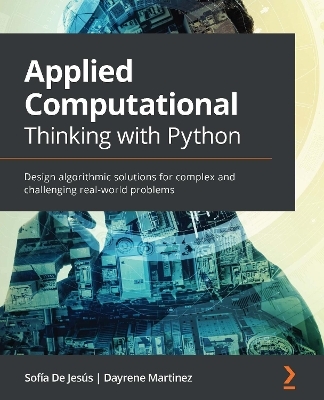
Applied Computational Thinking with Python
Packt Publishing Limited (Verlag)
978-1-83921-943-6 (ISBN)
Use the computational thinking philosophy to solve complex problems by designing appropriate algorithms to produce optimal results across various domains
Key Features
Develop logical reasoning and problem-solving skills that will help you tackle complex problems
Explore core computer science concepts and important computational thinking elements using practical examples
Find out how to identify the best-suited algorithmic solution for your problem
Book DescriptionComputational thinking helps you to develop logical processing and algorithmic thinking while solving real-world problems across a wide range of domains. It's an essential skill that you should possess to keep ahead of the curve in this modern era of information technology. Developers can apply their knowledge of computational thinking to solve problems in multiple areas, including economics, mathematics, and artificial intelligence.
This book begins by helping you get to grips with decomposition, pattern recognition, pattern generalization and abstraction, and algorithm design, along with teaching you how to apply these elements practically while designing solutions for challenging problems. You’ll then learn about various techniques involved in problem analysis, logical reasoning, algorithm design, clusters and classification, data analysis, and modeling, and understand how computational thinking elements can be used together with these aspects to design solutions. Toward the end, you will discover how to identify pitfalls in the solution design process and how to choose the right functionalities to create the best possible algorithmic solutions.
By the end of this algorithm book, you will have gained the confidence to successfully apply computational thinking techniques to software development.
What you will learn
Find out how to use decomposition to solve problems through visual representation
Employ pattern generalization and abstraction to design solutions
Build analytical skills required to assess algorithmic solutions
Use computational thinking with Python for statistical analysis
Understand the input and output needs for designing algorithmic solutions
Use computational thinking to solve data processing problems
Identify errors in logical processing to refine your solution design
Apply computational thinking in various domains, such as cryptography, economics, and machine learning
Who this book is forThis book is for students, developers, and professionals looking to develop problem-solving skills and tactics involved in writing or debugging software programs and applications. Familiarity with Python programming is required.
Sofía De Jesús is a computational thinking teacher with a degree from the University of Puerto Rico with a focus on math. She has a master’s degree from the University of Dayton. Her experience in education and development spans two decades. She has worked with clients to develop solutions in multiple programming languages. As a teacher, Sofía helps students incorporate the philosophy of computational thinking in courses like game design, circuits, Python, web design, and robotics. She likes to play video games and spend time with her 11 year old Yorkie, King Kong. Sofía also enjoys creating materials, small furniture, and jewelry using CNC machines and laser cutters. She enjoys spending as much time in Puerto Rico as work and life permits. Dayrene Martinez is a Systems Engineer in the Defense Industry where she develops neural networks embedded in real-time software to aid in decision making for aerospace vehicles. She received a B.S. in Electrical Engineering from the New Jersey Institute of Technology (NJIT). Dayrene is passionate about STEM education and volunteers her free time to inspire the next generation of engineers. She is an active supporter and keynote speaker for the non-profit organization Latinas in STEM. She teaches middle and high school students circuitry, robotics design and software engineering.
Table of Contents
Fundamentals of Computer Science
Elements of Computational Thinking
Understanding Algorithms and Algorithmic Thinking
Understanding Logical Reasoning
Exploring Problem Analysis
Designing Solutions and Solution Processes
Identifying Challenges within Solutions
Introduction to Python
Understanding Input and Output to Design a Solution Algorithm
Control Flow
Using Computational Thinking and Python in Simple Challenges
Using Python in Experimental and Data Analysis Problems
Using Classification and Clusters
Using Computational Thinking and Python in Statistical Analyses
Applied Computational Thinking Problems
Advanced Applied Computational Thinking Problems
| Erscheinungsdatum | 15.01.2021 |
|---|---|
| Verlagsort | Birmingham |
| Sprache | englisch |
| Maße | 75 x 93 mm |
| Themenwelt | Mathematik / Informatik ► Informatik ► Programmiersprachen / -werkzeuge |
| Informatik ► Software Entwicklung ► Objektorientierung | |
| Mathematik / Informatik ► Informatik ► Theorie / Studium | |
| ISBN-10 | 1-83921-943-2 / 1839219432 |
| ISBN-13 | 978-1-83921-943-6 / 9781839219436 |
| Zustand | Neuware |
| Haben Sie eine Frage zum Produkt? |
aus dem Bereich


